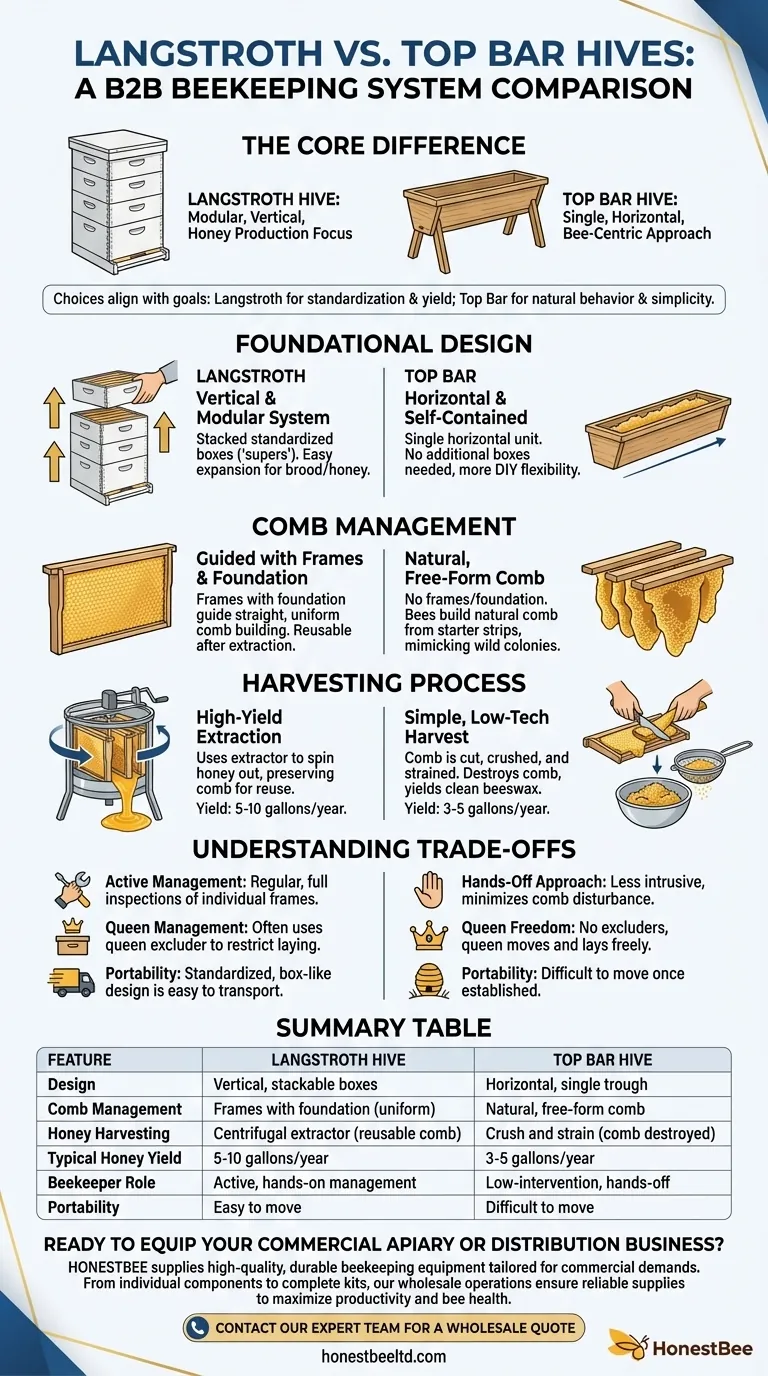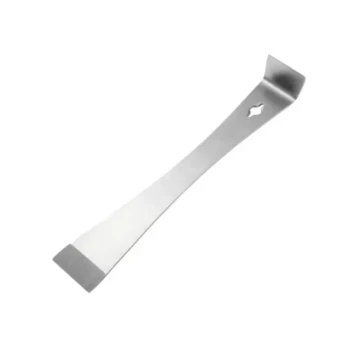At their core, the primary difference between a Langstroth hive and a top bar hive lies in their fundamental design and beekeeping philosophy. The Langstroth is a modular, vertical system of stackable boxes with removable frames, optimized for honey production and ease of management. In contrast, the top bar hive is a single, horizontal trough where bees build natural, free-form comb, reflecting a more hands-off, bee-centric approach.
The choice between these two hives is not about which is superior, but which system aligns with your goals. Langstroth hives prioritize standardization and honey yield, while top bar hives prioritize natural bee behavior and simplicity.

Foundational Design: Vertical vs. Horizontal
The most immediate difference is the physical structure of the hive itself. This design dictates how the colony expands and how the beekeeper interacts with it.
The Langstroth Hive: A Modular System
A Langstroth hive is composed of vertically stacked rectangular boxes, often called "supers." This design is modular.
As the colony grows and needs more space for brood or honey, the beekeeper simply adds more boxes. All components have standardized dimensions, meaning parts are interchangeable between hives.
The Top Bar Hive: A Self-Contained Ecosystem
A top bar hive is a single, long horizontal box that sits on legs. The colony expands horizontally along the length of the hive rather than vertically.
Because it is a self-contained unit, there are no additional boxes to add and dimensions do not need to be exact, offering more flexibility for DIY construction.
Comb Management: Guided vs. Natural
How bees build their comb is a central philosophical difference between the two systems, directly impacting both bee behavior and the beekeeper's role.
Langstroth Frames and Foundation
Langstroth hives use rectangular frames that hold a sheet of foundation—typically wax or plastic imprinted with a honeycomb pattern. This foundation guides the bees to build straight, uniform combs.
These durable frames can be removed, inspected, and placed back in the hive without damage. Crucially, the comb can be reused after honey harvesting.
Top Bar Natural Comb Building
Top bar hives do not use frames or foundation. Instead, they use simple wooden bars that span the top of the hive.
Bees build their comb naturally, hanging down from a small starter strip or guide on the bar. This allows for a natural cell size and comb structure, more closely mimicking a wild colony.
The Harvesting Process: Extraction vs. Crush and Strain
Harvesting honey is a vastly different experience with each hive, involving different equipment, effort, and outcomes for both the honey and the comb.
Langstroth: High-Yield Extraction
To harvest from a Langstroth hive, you remove the frames and use specialized equipment like a hot knife and a centrifugal extractor to spin the honey out.
This process preserves the delicate wax comb, which can be returned to the hive. Because the bees don't have to expend energy rebuilding comb, they can produce more honey, with annual yields of 5-10 gallons being common.
Top Bar: Simple, Low-Tech Harvest
Harvesting from a top bar hive is simpler. The beekeeper cuts the entire comb from the top bar. The honey is then extracted by crushing the comb and straining it through a filter.
This method destroys the comb but requires no special equipment beyond basic kitchen utensils. While it results in a lower honey yield (3-5 gallons), it produces a valuable secondary product: clean beeswax.
Understanding the Trade-offs
Choosing a hive means accepting a set of compromises. The advantages of one system are often the disadvantages of the other.
Beekeeper Intervention
The Langstroth system is designed for active management. Full hive inspections involve removing and checking individual frames for pests, brood patterns, and queen health.
Top bar beekeeping encourages a more hands-off approach. Inspections are typically less intrusive, as disturbing the delicate, free-form comb can be risky.
Queen Management
In Langstroth hives, beekeepers often use a queen excluder to confine the queen to the lower brood boxes, keeping the upper honey supers free of eggs.
Top bar hives do not use excluders, giving the queen freedom to move and lay eggs throughout the colony as she would in nature.
Portability and Expansion
The standardized, box-like nature of Langstroth hives makes them far easier to move. This is a significant advantage if you need to relocate hives for pollination or to find better forage.
Making the Right Choice for Your Goal
Your personal beekeeping goals should be the deciding factor in your choice of hive.
- If your primary focus is maximizing honey production: Langstroth is the clear choice due to its higher yield and reusable comb.
- If your primary focus is a natural, low-intervention approach: The top bar hive's design better supports a bee-centric philosophy.
- If your primary focus is minimizing startup costs and equipment: The top bar hive is simpler to build and its harvesting requires no specialized machinery.
- If you anticipate moving your hives or expanding commercially: The Langstroth's modularity and standardization are significant advantages.
Ultimately, the best hive is the one that aligns with your philosophy and commitment level as a beekeeper.
Summary Table:
| Feature | Langstroth Hive | Top Bar Hive |
|---|---|---|
| Design | Vertical, stackable boxes | Horizontal, single trough |
| Comb Management | Frames with foundation for uniform comb | Natural, free-form comb on bars |
| Honey Harvesting | Centrifugal extractor (reusable comb) | Crush and strain (comb is destroyed) |
| Typical Honey Yield | 5-10 gallons per year | 3-5 gallons per year |
| Beekeeper Role | Active, hands-on management | Low-intervention, hands-off approach |
| Portability | Easy to move, ideal for pollination services | Difficult to move once established |
Ready to equip your commercial apiary or distribution business with the right hive system?
HONESTBEE supplies high-quality, durable beekeeping equipment—from individual Langstroth components to complete top bar hive kits—tailored for the demands of commercial beekeepers and distributors. Our wholesale-focused operations ensure you get the reliable supplies you need to maximize productivity and support bee health.
Contact our expert team today to discuss your specific needs and request a wholesale quote.
Visual Guide

Related Products
- Long Langstroth Style Horizontal Top Bar Hive for Wholesale
- Langstroth Bee Hives Bee Keeping Box for Beginners Beekeeping
- HONESTBEE Professional Multi-Functional Hive Tool with Ergonomic Wood Handle
- HONESTBEE Advanced Ergonomic Stainless Steel Hive Tool for Beekeeping
- Top Bar Beehive for Beekeeping Wholesales Kenya Top Bar Hive
People Also Ask
- What are the most popular types of hives besides the Langstroth? Top Bar & Horizontal Hives Explained
- What are the box management requirements for a top bar hive vs. Langstroth? Choose Your Hive Strategy
- What are the advantages of a top bar hive? Simpler, Bee-Centric Beekeeping for All
- What is a top bar bee hive? A Natural, Low-Stress Beekeeping Solution
- What are the benefits of a top bar hive? A Natural, Low-Impact Approach to Beekeeping



















